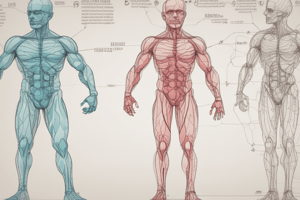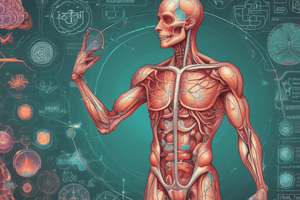Podcast
Questions and Answers
What is the maximum concentration of ketone bodies in the blood of a well-carbohydrate-fed human?
What is the maximum concentration of ketone bodies in the blood of a well-carbohydrate-fed human?
- 12 mmol/L
- 0.2 mmol/L (correct)
- 2 mmol/L
- 20 mmol/L
Which process does not occur inside the liver regarding ketone bodies?
Which process does not occur inside the liver regarding ketone bodies?
- Formation of acetoacetate
- Use as a precursor in cholesterol synthesis
- Excretion through the lungs (correct)
- Formation of acetyl-CoA
Which of the following is a primary fate of ketone bodies outside the liver?
Which of the following is a primary fate of ketone bodies outside the liver?
- Participates in the citric acid cycle inside the liver
- Serves as a precursor in cholesterol synthesis
- Reforms acetyl-CoA for energy production in extrahepatic tissues (correct)
- Forms acetoacetate
At which blood concentration of ketone bodies does the pathway for reforming acetyl-CoA in extrahepatic tissues become saturated?
At which blood concentration of ketone bodies does the pathway for reforming acetyl-CoA in extrahepatic tissues become saturated?
Which of the following tissues primarily uses ketone bodies as a fuel?
Which of the following tissues primarily uses ketone bodies as a fuel?
What happens to acetoacetate formed in the liver?
What happens to acetoacetate formed in the liver?
Flashcards are hidden until you start studying
Study Notes
Ketone Bodies in the Human Body
- In a well-carbohydrate-fed human, the blood concentration of ketone bodies does not exceed 0.2 mmol/L.
Fate of Ketone Bodies
- Inside the liver:
- Acetoacetate is used as a precursor in cholesterol synthesis.
- Outside the liver:
- Ketone bodies are excreted through the lungs (mainly acetone) and kidneys.
- Ketone bodies are converted back to acetyl-CoA in extrahepatic tissues, which then enters the citric acid cycle for energy production.
- Ketone bodies serve as a fuel for extrahepatic tissues, primarily the heart, skeletal muscles, and brain.
- The pathway from ketone bodies to energy production is saturated at a concentration of approximately 12 mmol/L.
Ketone Body Flow
- The liver produces ketone bodies, which are then transported to the blood.
- In the blood, ketone bodies are either excreted through the lungs and kidneys or transported to extrahepatic tissues.
- In extrahepatic tissues, ketone bodies are converted back to acetyl-CoA, which enters the citric acid cycle for energy production, ultimately producing 2CO2.
Studying That Suits You
Use AI to generate personalized quizzes and flashcards to suit your learning preferences.



